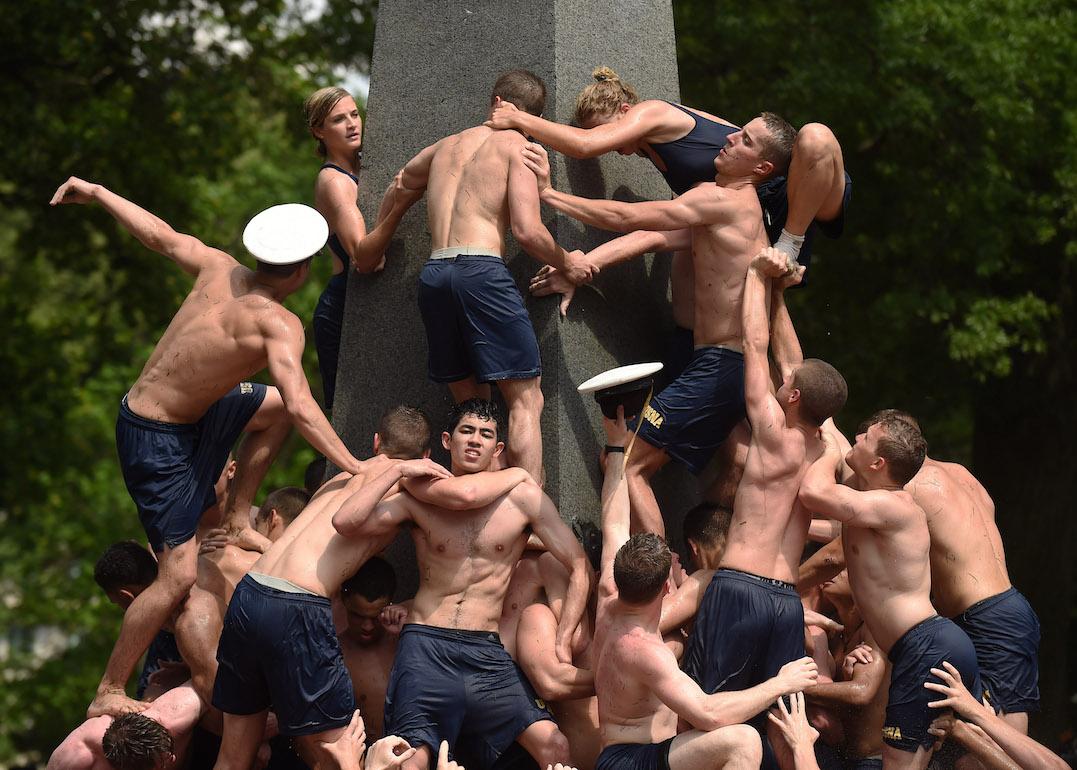
Do you know your military traditions?
Tradition plays an important role in military life for many reasons: It provides a sense of continuity between the generations, upholds morale, and instills pride.
Becoming part of a cultural custom helps new recruits acclimate to unfamiliar environments. Tradition can also provide comfort in an industry where life itself isn't guaranteed. Some military traditions are solemn for this reason while others are more celebratory.
Stacker researched various military traditions that have been carried on by generations. Some reach back into the mists of time and others are recent additions. Traditions are particularly prevalent in military academies and schools, where cadets become the officers that will lead teams of American soldiers around the world. Wherever members of the armed forces serve their country, many look to these rituals to guide their actions.
Continue reading to learn about 10 military traditions and what they represent.
Crossing the equator
When sailors cross the equator for the first time, they’re inducted into the Court of Neptune. It’s a time-honored ceremony in which someone dressed as King Neptune forces ‘Pollywogs’—sailors crossing the equator for the first time—to undergo a variety of challenges, like drinking hot sauce or crawling to King Neptune. When it’s over, the sailor is part of the fraternity of veterans who have seen the world—or at least the other half of it.
The Herndon Monument climb
At the U.S. Naval Academy in Annapolis, Maryland, naval midshipmen at the end of their first year attack the Herndon Monument to retrieve a hat at the top. Before the climb up the 21-foot-tall granite obelisk begins, the monument is greased with lard. As a result, it has taken as long as four hours to complete the struggle. The tradition, established in 1940, teaches teamwork and cooperation. It’s said that the person who reaches the hat will be the first member of the class to reach the rank of admiral.
All washed up
When U.S. Air Force pilots complete their final career flight, they’re soaked with water—symbolizing a career that’s “all washed up.” Sometimes this is done on a small scale by comrades with hoses, and sometimes on a large scale by way of a fire truck. Pilots who go on their first solo flights are also sometimes doused with water upon their return.
Water salute
This is another water-based tradition. When a pilot flies away from an airbase for duty overseas, fire trucks will form an arc of water as a salute over the aircraft as it taxis down the runway. This custom is upheld at air bases as well as some airports.
Wetting down the captain
In the U.S. Navy, when an officer attains the prestigious rank of captain—reached by fewer than 3% of officers—they are tossed into the water in full uniform, making the new captain 'salty.' In one instance, an exception was made: When Capt. Julie Green was promoted in February 2014, inclement weather prevented the ocean toss. Seawater was poured over her shoulder boards to honor the tradition.
Guard mounting
Around the world, ceremonial guards at important sites are relieved of their shifts in traditional ceremonies known as “guard mounting.” These reflect ancient drills, precision marches, and the solemnity of handing over the responsibility for defending the site. The best-known American guard mounting is the changing of the guard at Arlington National Cemetery’s Tomb of the Unknowns. In Britain, the most famous guard mounting ceremony is the changing of the guard at Buckingham Palace.
Canadian Christmas dinner
In an effort to boost morale and honor the lower ranks, Canadian forces enjoy a holiday feast in which roles are reversed: Senior officers organize the event and serve the food to the lower ranks. Sometimes they even switch uniforms, and the youngest soldier in the unit takes command for a day.
Flags flown at half-staff
Flags are flown at half-staff to denote respect while mourning a figure of national importance or to signify a matter of national distress. Tradition governs the process as well, with the flag first raised to the top of the pole before being lowered to the half-staff position.
Missing man formation
The missing man formation, also known as a flyby or flypast, honors a fallen or departed airman or special honoree. A flight of aircraft passes over or salutes a funeral or ceremony, and one breaks formation to denote the missing person. The first recorded flyby to honor a non-Air Force person was in 1936 to mark the passing of King George V.
Military songs
Militaries around the world have maintained an oral tradition in the form of music, like battle cries intended to rally troops and folk songs that recount the history of events or individuals. From the British-penned "Belgium Put the Kibosh on the Kaiser" to the Oscar-nominated American "Boogie Woogie Bugle Boy" and Japanese "Teki Wa Ikuman," there's no shortage of military tradition in these enduring tunes that unite soldiers of all generations.



